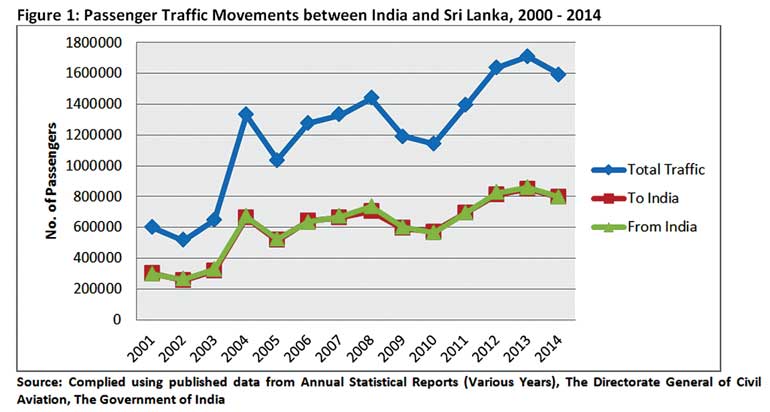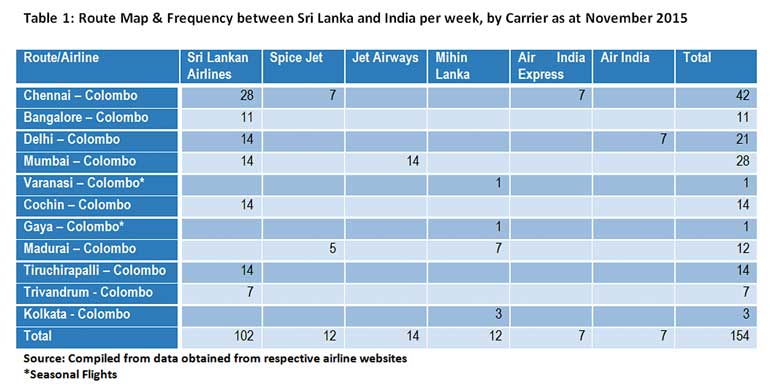Monday Mar 17, 2025
Monday Mar 17, 2025
Thursday, 21 January 2016 00:00 - - {{hitsCtrl.values.hits}}
 By Raveen Ekanayake
By Raveen Ekanayake
Air connectivity plays a pivotal role in unlocking a country’s long term economic growth potential, and has been recognised as doing so over the recent decades. Air connectivity is an indicator of a network’s concentration and ability to move passengers and goods from a point of origin to another destination with ease and efficiency. The level of air connectivity a country possesses is believed to have a significant impact on its economic growth.
In addition to the direct and indirect contribution of the aviation sector to aggregate output, enhanced air connectivity leads to many spin off impacts on the wider economy. It enables business travellers to meet new customers and suppliers in order to expand their operations on a global scale. It is also considered a fundamental prerequisite in unleashing a country’s/region’s tourism potential.
Connectivity within South Asia
Despite clear benefits of enhanced air connectivity, many countries and regions of the world are plagued by poor air connectivity. Outdated rules and regulations often prevent fit, willing and able airlines from fully serving passengers and shippers, severely inhibiting air connectivity in these regions.
South Asia is one such region; its countries are better connected with countries outside the region, than within, mainly due to regulatory barriers on airline operations. In many instances, there is a lack of direct capital to capital air connectivity (e.g. Sri Lanka-Nepal, Sri Lanka-Bhutan, Afghanistan-Sri Lanka, and Afghanistan-Bangladesh, etc.).
Travelling to these destinations requires a transit either via a Middle Eastern or a Southeast Asian destination, leading to additional travel time and costs. The limited regional air connectivity is widely seen as a critical barrier stifling the growth of intra-regional trade and investment.
Liberalisation of air services between India and Sri Lanka
Amongst the South Asian countries, Sri Lanka and India are by far the best connected (See Table 1) and this could be linked to the extensive liberalisation of the air services regulations between the two countries, which took place in 2003. The most pertinent liberalisations in this respect were in the areas of pricing, competition, capacity and new routes. Market forces were allowed to determine prices as opposed to being set by the two governments.
Following the deregulation of the domestic aviation market in India, private Indian airlines were allowed to operate between the two countries and there was a shift in regulating capacity from a regime based on the number of weekly seats, to one based on the number of weekly frequencies.
In addition to the opening up of a number of metropolitan (Mumbai, Delhi) (7) and secondary destinations (18) in India, frequencies (capacity) to these destinations were enhanced (from an equivalent of 27 weekly frequencies to 49 weekly frequencies per designated airline for metropolitan destinations and unlimited weekly frequencies to secondary destinations in India). Frequencies were further enhanced in 2011 to 112 weekly frequencies.

More frequencies, more destination, more airlines
As noted in the table below, liberalisation has led to an overall improvement in connectivity in terms of frequencies and routes between the two countries. Whilst a number of private Indian airlines have started operating between the two countries, the two airlines in Sri Lanka, (i.e. Sri Lankan and Mihin Lanka), account for the lions share (74%) of the market. In the immediate aftermath of liberalisation, a downward revision in airfares was observed. However in the absence of sufficient competition on these routes, air fares have gradually crept up to pre-liberalisation levels.
The benefits of liberalisation are clear, as noted in Figure 1 below, passenger traffic between the two countries more than doubled in the immediate wake of liberalisation in 2003 and has since increased. The bulk of the new traffic being generated is a result of the relaxation of capacity constraints on metropolitan destinations.

Facilitating the movement of people
The improvement in air connectivity has facilitated the movement of people to forge trade, investment, and cultural linkages between the two countries. The tourism industry in Sri Lanka in particular has been a major beneficiary. The adverse security situation, which prevailed up to 2003, saw tourist arrivals from Sri Lanka’s traditional sources in the West dry up.
India with its growing middle class, close geographical proximity and its people being less sensitive to the adverse security situation in Sri Lanka, was seen as the ideal market to tap. Improved air connectivity with India ensured that the void left by the hollowing out of Western tourists filled and in the process ensuring that the hotel sector in particular was kept afloat during these turbulent times.
During the early 2000s, India in terms of volume was the 3rd top source of tourist arrivals to Sri Lanka after the United Kingdom and Germany. By 2004, India had jumped to the 2nd place and by 2005, India become the top source of tourists to Sri Lanka, surpassing the United Kingdom by as much as 20% in terms of tourist numbers. Since then India stands as the top source of tourist arrivals to the island.
With the end of the war in Sri Lanka, there has seen a noticeable uptake in tourist arrivals from the West. However, tourist arrivals from India still play a crucial role. The peak tourist season for European tourists run from September to January during winter months in the Western Hemisphere, whereas the peak season for Indian tourist runs between March to April and June to August during school holidays and the summer season in India. As such tourist arrivals from India support the local tourism industry during the lean seasons between February and August each year.
In addition to pleasure travellers, there has also been an increase in business travellers between the two countries. This has been a notable feature in the wake of the India-Lanka Free Trade Agreement being operationalised in 2000, an indication that air connectivity is facilitating more business to business interactions between the two countries.
Closer inspection of the composition of Sri Lankan tourists arrivals to India also suggests that in addition to pleasure tourists and business travellers, there has been a notable growth of Sri Lankans travelling to India for medical purposes as well as for education, which has been facilitated by better air connectivity; an indication that air connectivity is also facilitating the trade in services.
The way forward
As highlighted above, the liberalisation of air services between Sri Lanka and India has brought about a number of tangible benefits to the Sri Lankan economy by way of facilitating the movement of people and business between the two countries.
Despite the improvements in connectivity, further scope for improvements in air services between the two countries exists. The lack of competition could be attributed to the prevalence of high airfares. In this regard, both countries must seek to enhance competition amongst the airlines operating on the route to ensure that air travel is made much more affordable.
Finally, South Asia is a fast growing region with a growing middle class and Sri Lanka must look at undertaking similar liberalisation with other South Asian member states to forge deeper trade, investment and cultural linkages in the interest of further unleashing the potential of the domestic economy.
(Raveen Ekanayake is a Research Officer at the Institute of Policy Studies of Sri Lanka (IPS). To view this article online and share your comments visit the IPS Blog – Talking Economics – http://www.ips.lk/talkingeconomics/.)
Discover Kapruka, the leading online shopping platform in Sri Lanka, where you can conveniently send Gifts and Flowers to your loved ones for any event including Valentine ’s Day. Explore a wide range of popular Shopping Categories on Kapruka, including Toys, Groceries, Electronics, Birthday Cakes, Fruits, Chocolates, Flower Bouquets, Clothing, Watches, Lingerie, Gift Sets and Jewellery. Also if you’re interested in selling with Kapruka, Partner Central by Kapruka is the best solution to start with. Moreover, through Kapruka Global Shop, you can also enjoy the convenience of purchasing products from renowned platforms like Amazon and eBay and have them delivered to Sri Lanka.
Discover Kapruka, the leading online shopping platform in Sri Lanka, where you can conveniently send Gifts and Flowers to your loved ones for any event including Valentine ’s Day. Explore a wide range of popular Shopping Categories on Kapruka, including Toys, Groceries, Electronics, Birthday Cakes, Fruits, Chocolates, Flower Bouquets, Clothing, Watches, Lingerie, Gift Sets and Jewellery. Also if you’re interested in selling with Kapruka, Partner Central by Kapruka is the best solution to start with. Moreover, through Kapruka Global Shop, you can also enjoy the convenience of purchasing products from renowned platforms like Amazon and eBay and have them delivered to Sri Lanka.